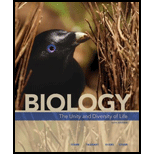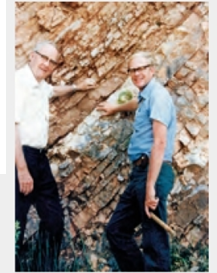
Concept explainers
Discovery of Iridium in the K–Pg Boundary Layer In the late 1970s, geologist Walter Alvarez was investigating the composition of the K–Pg boundary layer in different parts of the world. He asked his father, Nobel Prize–winning physicist Luis Alvarez, to help him analyze the elemental composition of the layer. The Alvarezes and their colleagues tested the K-Pg boundary layer in Italy and Denmark, and discovered that it contains a much higher iridium content than the surrounding rode layers (FIGURE 16.17). Iridium belongs to a group of elements that are much more abundant in asteroids and other solar system materials than they are in Earth’s crust. The Alvarez group concluded that the K–Pg boundary layer must have originated with extraterrestrial material.
| Sample Depth | Average Abundance of Iridium (ppb) |
| +2.7m | <0.3 |
| +1.2m | <0.3 |
| +0.7m | 0.36 |
| boundary layer | 41.6 |
| –0.5 m | 0.25 |
| –5.4 m | 0.30 |

FIGURE 16.17 Abundance of iridium in and near the K–Pg boundary layer.
Iridium content of rock samples above, below, and at the K–Pg boundary layer in Stevns Klint, Denmark. Sample depths are given as meters above or below the layer. ppb, parts per billion. An average Earth rock contains 0.4 ppb iridium; the average meteorite, 550 ppb. The photo shows Luis and Walter Alverez next to the K–Pg boundary layer in Stevns Klint.
What was the iridium content of the K–Pg boundary layer?
To determine: The iridium content of the K–Pg boundary layer.
Introduction: The iridium is a chemical element that is abundantly found in the Cretaceous–Paleogene (K–Pg) boundary layer. The iridium level in an average rock is about 0.4 ppb, and in an average meteorite, it is about 550 ppb. This allows scientists to conclude whether the origin of the rocks is from the Earth or from any other sources.
Explanation of Solution
As given in the problem statement, Researcher W examined the composition of the K–Pg boundary layer in various parts of the world. He took help from his father to examine the composition of elements in the layer. Researcher L and his colleagues tested the K–Pg boundary layer in Country D and Country I. They discovered that the iridium content was found to be in large quantity than the surrounding rock layers. They also concluded that the boundary layer may have originated with the extraterrestrial material.
Refer to Fig. 16.17, “Abundance of iridium in and near the K-Pg boundary layer”, in the textbook. The given table shows the average abundance of iridium (ppb), and the sample depth (in meters) in Country D. The chemical element iridium was found in abundance on an average of about 41.6 ppb in the K–Pg boundary layer.
The iridium content was 41.6 ppb in the K–Pg boundary layer.
Want to see more full solutions like this?
Chapter 16 Solutions
Biology: The Unity and Diversity of Life (MindTap Course List)
Additional Science Textbook Solutions
Genetics: From Genes to Genomes
Biological Science (6th Edition)
Laboratory Manual For Human Anatomy & Physiology
Campbell Biology in Focus (2nd Edition)
Chemistry: Structure and Properties (2nd Edition)
- What is behavioral adaptarrow_forward22. Which of the following mutant proteins is expected to have a dominant negative effect when over- expressed in normal cells? a. mutant PI3-kinase that lacks the SH2 domain but retains the kinase function b. mutant Grb2 protein that cannot bind to RTK c. mutant RTK that lacks the extracellular domain d. mutant PDK that has the PH domain but lost the kinase function e. all of the abovearrow_forwardWhat is the label ?arrow_forward
- Can you described the image? Can you explain the question as well their answer and how to get to an answer to an problem like this?arrow_forwardglg 112 mid unit assignment Identifying melting processesarrow_forwardGive only the mode of inheritance consistent with all three pedigrees and only two reasons that support this, nothing more, (it shouldn't take too long)arrow_forward
- Oarrow_forwardDescribe the principle of homeostasis.arrow_forwardExplain how the hormones of the glands listed below travel around the body to target organs and tissues : Pituitary gland Hypothalamus Thyroid Parathyroid Adrenal Pineal Pancreas(islets of langerhans) Gonads (testes and ovaries) Placentaarrow_forward
 Biology Today and Tomorrow without Physiology (Mi...BiologyISBN:9781305117396Author:Cecie Starr, Christine Evers, Lisa StarrPublisher:Cengage Learning
Biology Today and Tomorrow without Physiology (Mi...BiologyISBN:9781305117396Author:Cecie Starr, Christine Evers, Lisa StarrPublisher:Cengage Learning Biology: The Unity and Diversity of Life (MindTap...BiologyISBN:9781337408332Author:Cecie Starr, Ralph Taggart, Christine Evers, Lisa StarrPublisher:Cengage Learning
Biology: The Unity and Diversity of Life (MindTap...BiologyISBN:9781337408332Author:Cecie Starr, Ralph Taggart, Christine Evers, Lisa StarrPublisher:Cengage Learning Biology: The Unity and Diversity of Life (MindTap...BiologyISBN:9781305073951Author:Cecie Starr, Ralph Taggart, Christine Evers, Lisa StarrPublisher:Cengage Learning
Biology: The Unity and Diversity of Life (MindTap...BiologyISBN:9781305073951Author:Cecie Starr, Ralph Taggart, Christine Evers, Lisa StarrPublisher:Cengage Learning
 Biology 2eBiologyISBN:9781947172517Author:Matthew Douglas, Jung Choi, Mary Ann ClarkPublisher:OpenStax
Biology 2eBiologyISBN:9781947172517Author:Matthew Douglas, Jung Choi, Mary Ann ClarkPublisher:OpenStax





